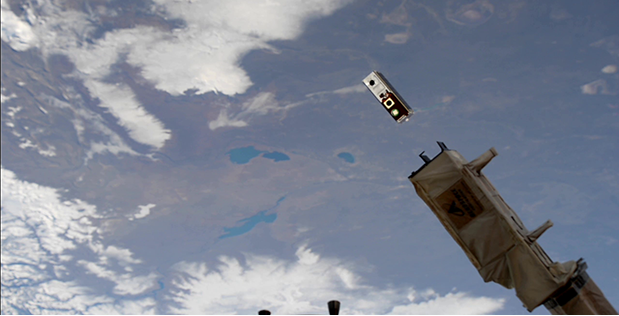
DeMi CubeSat deployed from International Space Station July 13; microelectromechanical systems deformable mirrors could make future space telescopes more compact
Jul 28, 2020
A recently deployed DARPA CubeSat seeks to demonstrate technology that could improve imaging of distant objects in space and allow powerful space telescopes to fit into small satellites. DARPA’s Deformable Mirror (DeMi) CubeSat deployed from the International Space Station July 13, beginning the technology demonstration of a miniature space telescope with a small deformable mirror called a microelectromechanical systems (MEMS) mirror.
DeMi made first contact about a week following launch, demonstrating the expected power from its solar arrays, as well as correct spacecraft pointing and stable temperatures. The team will focus on payload checkout over the coming days.
Deformable mirrors can adjust the shape of their reflective surfaces to correct for the effects of temperature and mechanical changes on a space telescope, improving image quality. The experiment will measure how well a MEMS deformable mirror performs in space, from the rocket launch through its time in orbit experiencing the thermal and radiation environment.
“Space telescopes currently in orbit are limited in ability to detect and distinguish small, dim objects next to large, bright objects – for example, dim exoplanets next to bright stars. Deformable mirrors have proven successful in ground-based applications, but their performance has not been tested in long duration space operations,” said Stacie Williams, the program manager for DeMi in DARPA’s Tactical Technology Office. “Our goal is to demonstrate the benefits of a MEMS deformable mirror to actively correct the images of distant objects in space.”
The primary mirror of the DeMi telescope is about an inch wide, and the deformable mirror surface is about the size of a dime. The DeMi payload can observe stars with the telescope and use an internal laser for calibration measurements of the deformable mirror. When the payload observes stars, the deformable mirror will keep the star centered on the imaging camera. The MEMS mirror has 140 actuators, tiny moving surfaces that control the mirror shape. Calibration measurements will track the performance using about 50 actuators over time in the space environment.
DeMi also aims to demonstrate wavefront correction, where the payload measures the wavefront, or shape of misalignments in the optical system. The deformable mirror corrects these errors by changing shape, acting like the opposite of a distorting funhouse mirror. After making observations, the DeMi spacecraft will downlink images from the wavefront sensors so operators can monitor the deformable mirror behavior from the ground.
The DARPA DeMi team includes Aurora Flight Sciences; Massachusetts Institute of Technology, which designed and built the optical payload; and Blue Canyon Technologies, which designed and built the spacecraft bus. DeMi arrived to the space station in February aboard a cargo resupply mission, packed into a NanoRacks CubeSat Deployer. The mission is anticipated to last about a year.
Image Caption: DARPA’s Deformable Mirror CubeSat deployed from the International Space Station July 13. Image courtesy of NASA
# # #
Media with inquiries should contact DARPA Public Affairs at outreach@darpa.mil
Associated images posted on www.darpa.mil and video posted at www.youtube.com/darpatv may be reused according to the terms of the DARPA User Agreement, available here: http://go.usa.gov/cuTXR.
Tweet @darpa
